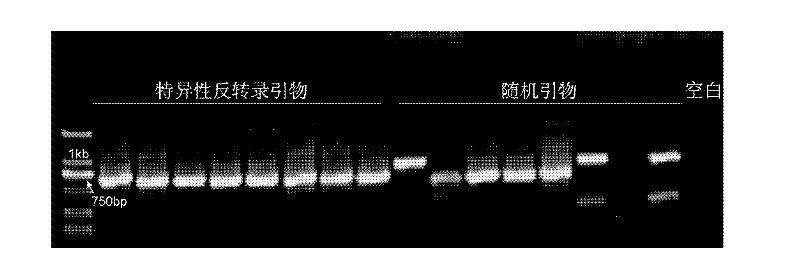Reverse transcription-polymerase chain reaction (RT-PCR) primer of human leukemia fusion gene BCR-ABL and application method thereof
A RT-PCR, fusion gene technology, applied in the field of life science and biology, can solve the problems of poor specificity, lack of whole blood samples, differences between mRNA quality samples, etc., to achieve the effect of improving the success rate of amplification
- Summary
- Abstract
- Description
- Claims
- Application Information
AI Technical Summary
Problems solved by technology
Method used
Image
Examples
Embodiment 1
[0031] The RT-PCR primers of the human leukemia fusion gene BCR-ABL of the present invention are shown in the following table:
[0032]
[0033] RT-PCR of human leukemia fusion gene BCR-ABL using the above primers:
[0034] 1. RNA extraction: Biomiga Blood RNA miniprep kit (Cat#R6411) was used to extract the mRNA of white blood cells in whole blood. For specific operations, refer to the kit product manual.
[0035] 2. Take 10ul of white blood cell RNA extract (concentration 100-200ng / ul), mix with 1μl (10pmol) reverse transcription primer (ABL_ex R), 65°C for 5 minutes, immediately transfer to ice for 1 minute.
[0036] 3. In the above reaction system, add 1 μl of reverse transcriptase (Toyobo ReverTra Ace qPCR RT Kit), 4 μl of reaction buffer (Toyobo ReverTra Ace qPCR RT Kit) and 4 μl of DEPC water. minutes, then turn to 98°C for 5 minutes.
[0037] 4. Take 1 μl of the reverse transcription reaction product as a PCR reaction template. The first round of PCR amplificatio...
Embodiment 2
[0057] Clinical sample verification: collect the whole blood samples of 50 cases of CML patients for experiments, use the primers of the present invention to carry out RT-PCR, the results are shown in the table below.
[0058]
[0059] From the results in the above table, it can be seen that 44 samples were positive by electrophoresis after the first round (outer) PCR, and were also positive by electrophoresis after the second round (inner) PCR, and a sequence containing the ABL kinase region was successfully amplified A fragment of about 0.7kb in length. Three samples were weakly positive by electrophoresis after the first (outer) round of PCR and positive by electrophoresis after the second (inner) round of PCR, and only three samples were tested by electrophoresis after the first and second rounds of PCR. Electrophoresis was negative. The success rate is 94%.
PUM
 Login to View More
Login to View More Abstract
Description
Claims
Application Information
 Login to View More
Login to View More - R&D
- Intellectual Property
- Life Sciences
- Materials
- Tech Scout
- Unparalleled Data Quality
- Higher Quality Content
- 60% Fewer Hallucinations
Browse by: Latest US Patents, China's latest patents, Technical Efficacy Thesaurus, Application Domain, Technology Topic, Popular Technical Reports.
© 2025 PatSnap. All rights reserved.Legal|Privacy policy|Modern Slavery Act Transparency Statement|Sitemap|About US| Contact US: help@patsnap.com



